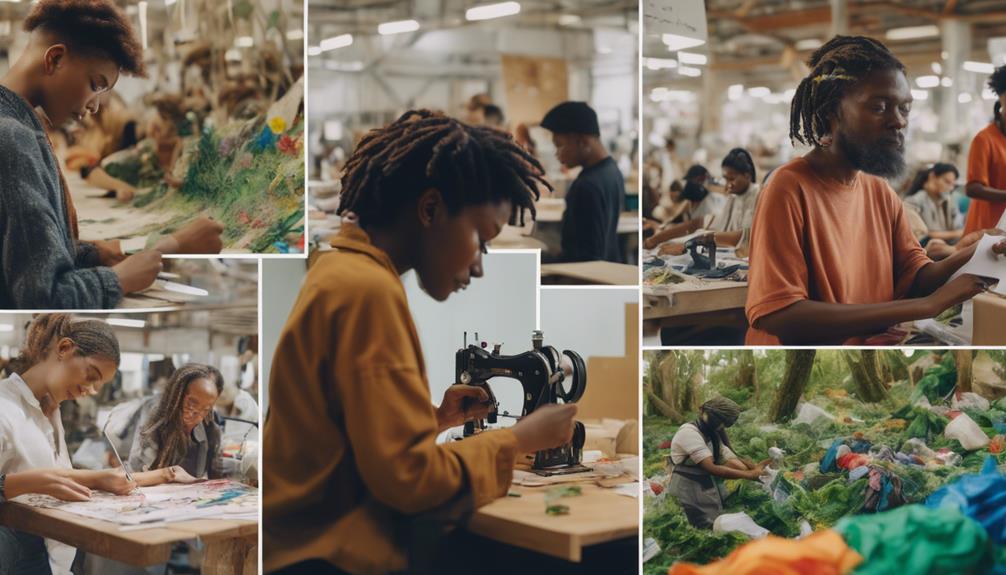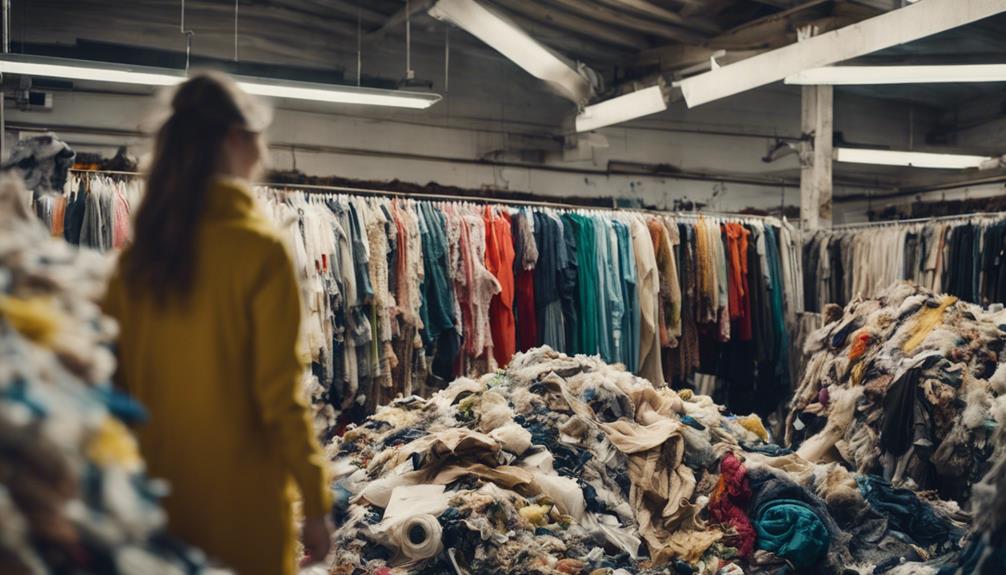Sustainable fashion is not only the responsibility of brands; it is a shared obligation that involves you, the consumer, as well as companies and communities. Your role is crucial in selecting eco-friendly products and endorsing ethical brands. Simultaneously, the fashion industry needs to prioritize transparency, accountability, and fair labor practices. Awareness of greenwashing is crucial, as many brands tend to overstate their sustainability efforts. By staying informed and making conscious choices, you can positively impact sustainable practices. The reality is that your decisions have the power to bring about tangible change in the industry, and there is much more to uncover about the journey towards sustainability.
Key Takeaways
- The fashion industry is a major contributor to greenhouse gas emissions and environmental degradation, accounting for 10% of global CO2 emissions.
- Fast fashion relies on labor exploitation, with many workers earning below a living wage and facing poor working conditions.
- Consumers play a crucial role, as their choices can drive demand for sustainable practices and reduce textile waste significantly.
- Brands often engage in greenwashing, misleading consumers about their sustainability efforts while maintaining harmful practices.
The Role of the Fashion Industry
The fashion industry plays an essential role in shaping our environment and social landscape, as it greatly impacts both pollution levels and labor practices worldwide. This $3 trillion industry is responsible for about 10% of global greenhouse gas emissions and a staggering 20% of global wastewater.
Fast fashion has accelerated clothing production to 80 billion pieces each year, leading to a 400% increase in consumption over the last two decades. You mightn't realize it, but the average consumer tosses out around 70 pounds of clothing annually, contributing to this environmental crisis.
Despite the industry's claims of sustainability, little has changed regarding reducing its environmental impact. Most garments still rely on non-biodegradable materials, which only exacerbates the issue.
Additionally, the fashion industry often exploits labor, ranking garments as the second highest at-risk product for modern slavery. This exploitation primarily affects women and people of color, who make up 80% of the workforce.
New business models like recycling and rental are emerging, but their effectiveness in genuinely reducing the industry's environmental impact remains in question. It's clear that systemic changes are vital for a sustainable future in fashion.
Consumer Responsibility in Sustainability

How can your choices as a consumer considerably impact sustainability in the fashion industry?
Your purchasing decisions directly influence the amount of textile waste generated; in the U.S. alone, consumers produce 16 million tons of it each year. By choosing to extend the life of your clothing by just nine months, you could help save approximately £5 billion in resources. This highlights the vital role of consumer responsibility in reducing waste.
A growing number of consumers—75%—value sustainability, and one-third actively seek out eco-friendly brands. This shift in mindset is paving the way for sustainable practices in fashion.
The secondhand clothing market is booming, projected to grow from $96 billion in 2021 to $218 billion by 2026. By opting for secondhand items, you're not just saving money; you're also making a significant impact on reducing the demand for new production.
Engaging in initiatives like Second Hand September fosters community awareness and emphasizes collective responsibility.
Understanding Greenwashing Tactics
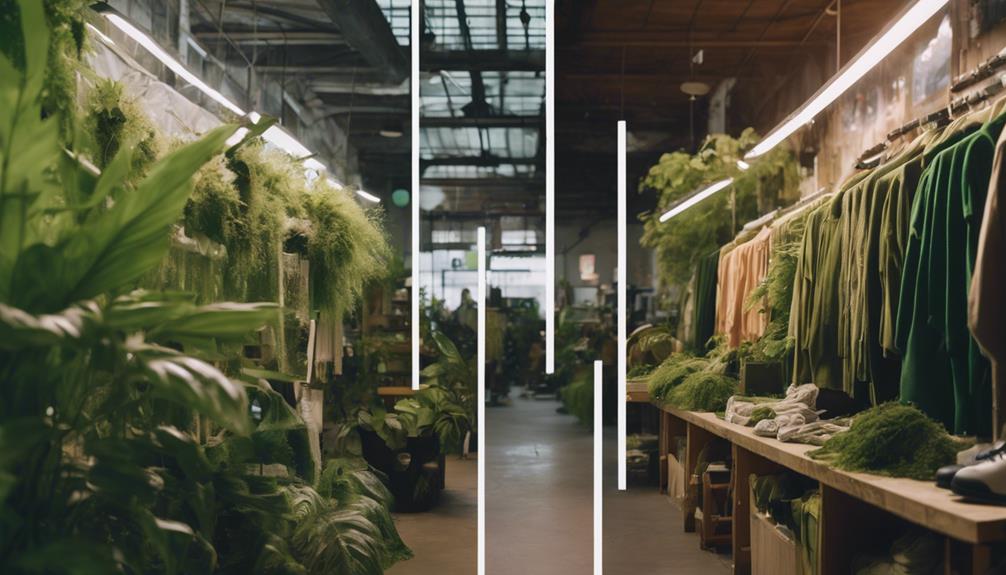
Understanding greenwashing tactics is essential for consumers who want to make genuinely sustainable choices in the fashion industry. Greenwashing occurs when brands exaggerate or falsely claim their sustainability efforts, using misleading marketing language to appear eco-friendly without making real changes to their practices. Many established brands showcase sustainable product lines while continuing practices that harm the environment, leading to doubt about their true commitment to sustainable fashion.
The fashion industry's lack of transparency about sourcing, production processes, and material origins allows greenwashing to thrive. This makes it tough for you to make informed choices. Although about 75% of consumers value sustainability, many don't recognize the difference between truly sustainable brands and those simply engaging in greenwashing.
Moreover, the term 'sustainable' is often used loosely, with products marketed as eco-friendly despite being made from non-biodegradable materials or having a negligible impact on reducing environmental harm. By educating yourself on these tactics, you can better discern which brands genuinely prioritize sustainability and which merely use greenwashing to mislead consumers.
Staying informed empowers you to support brands that align with your values in sustainable fashion.
The Impact of Fast Fashion
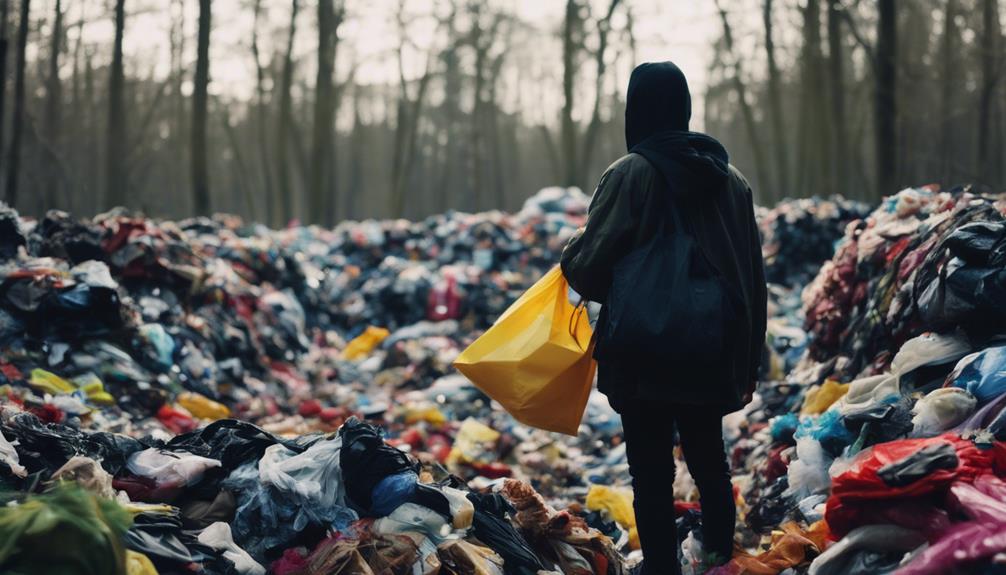
Fast fashion isn't just about trendy outfits; it has serious environmental consequences that you mightn't realize.
From massive carbon emissions to overwhelming textile waste, your shopping choices play a big role in this issue.
Plus, understanding the labor exploitation that often accompanies cheap clothing can help you make more responsible decisions.
Environmental Consequences
The fashion industry's relentless pursuit of trends drives significant environmental harm, contributing to severe pollution and resource depletion. Fast fashion's impact is staggering, with approximately 10% of global CO2 emissions linked to this industry. This figure surpasses emissions from both aviation and shipping combined, highlighting the urgent need for change. You might be surprised to learn that the fashion sector produces 20% of global wastewater, and this number is expected to rise by 50% by 2030.
Here's a quick breakdown of the environmental consequences:
| Aspect | Impact |
|---|---|
| Greenhouse Gas Emissions | 10% of global CO2 emissions |
| Water Footprint | 20% of global wastewater |
| Waste Footprint | Over 300,000 tonnes of clothing wasted annually |
Moreover, producing just one cotton shirt generates emissions equivalent to driving 35 miles. With over 300,000 tonnes of clothing wasted each year, 20% ends up in landfills, while 80% is incinerated, further exacerbating our waste footprint. Fast fashion is not just a trend; it's an environmental crisis we can't ignore.
Labor Exploitation Issues
Labor exploitation in the fashion industry reveals a dark reality where workers endure poor conditions and meager wages while companies rake in massive profits. Fast fashion thrives on this exploitation, leaving workers trapped in a cycle of poverty.
Imagine:
- Workers toiling in cramped, unsafe factories, breathing in toxic fumes.
- Earners making less than a living wage, barely able to afford basic necessities.
- Women and people of color facing systemic discrimination, their voices silenced.
In countries like Bangladesh, garment workers earn only 4.5 times the minimum wage needed for a decent living, while fast fashion brands profit immensely. The majority of these workers are women and people of color, representing 80% of the workforce.
This systemic inequality not only affects individual livelihoods but also perpetuates global injustices. You might think twice about the true cost of those bargain deals, knowing that behind every garment lies a story of labor exploitation.
Fast fashion's impact is profound and far-reaching, highlighting the urgent need for change in the industry.
Consumer Awareness Importance
As consumers, your choices directly influence the fashion industry's practices and its impact on the environment. Fast fashion contributes to 10% of global CO2 emissions, surpassing the combined emissions from aviation and shipping. This staggering fact highlights the urgent need for consumer awareness about the environmental consequences of your purchasing habits. Each year, around 80 billion pieces of clothing flood the market, which is a 400% increase in production over the last two decades.
With an estimated 300,000 tonnes of clothing wasted annually—20% ending up in landfills and 80% incinerated—it's clear that you must rethink your consumption patterns. By simply extending the life of your clothing by just nine months, you could save approximately £5 billion in resources.
Interestingly, 75% of consumers value sustainability, and one-third say they're willing to choose eco-friendly brands. This shows that your choices can considerably drive demand for sustainable alternatives. By being more mindful and informed, you can help shift the fashion industry towards practices that prioritize sustainability, making a real difference in the fight against fast fashion's detrimental effects.
Ethical Sourcing and Production

Ethical sourcing and production are essential for transforming the fashion industry into a more sustainable and responsible sector. By prioritizing these practices, you can help reduce environmental damage and improve worker conditions.
Here's what ethical sourcing looks like:
- Organic cotton: Grown without harmful pesticides, benefiting both the planet and farmers.
- Natural dyes: Using plant-based alternatives to minimize toxic chemical use in fabric treatments.
- Fair labor practices: Ensuring workers receive fair wages and work in safe environments.
The fashion industry currently uses around 43 million tons of chemicals annually, highlighting the urgent need for change.
Conventional cotton farming consumes a staggering amount of pesticides, while over 90% of emissions stem from dyeing and fabric production.
Sadly, only 1% of textiles are reused despite their recyclability. Fast fashion brands often focus on cutting costs, which leads to exploitation and poor working conditions.
Innovations in Sustainable Practices

When you think about sustainable fashion, consider how eco-friendly materials and innovative recycling techniques are reshaping the industry.
By opting for materials like recycled plastics and organic cotton, you can greatly lessen the environmental impact of your wardrobe.
Plus, embracing new recycling methods opens the door to a more circular approach, allowing garments to have a longer life cycle.
Eco-Friendly Material Usage
Innovative eco-friendly materials, like organic cotton and recycled polyester, are transforming the fashion industry by reducing its environmental impact and reliance on harmful textiles. These alternatives not only promote sustainable practices but also pave the way for a greener future.
As you explore the world of sustainable fashion, you'll notice the following benefits of eco-friendly materials:
- Organic cotton: Grown without harmful pesticides, it minimizes chemical use and supports healthier ecosystems.
- Recycled polyester: Made from plastic bottles, it diverts waste from landfills and reduces reliance on fossil fuels.
- Tencel: Produced from sustainably sourced wood pulp, it's biodegradable and requires less water than conventional fabrics.
The need for such materials is urgent, as the fashion industry uses around 43 million tons of chemicals annually. With 80 billion pieces of clothing produced each year, embracing eco-friendly materials is essential for mitigating pollution and fostering a circular fashion economy.
Innovative Recycling Techniques
As you embrace eco-friendly materials, it's important to recognize how innovative recycling techniques are reshaping the fashion landscape and maximizing resource recovery. Despite 95% of textiles being recyclable, only 1% is currently reused. This gap shows the immense potential for improvement. By adopting a circular fashion model, brands can promote reuse, repair, and recycling, aiming to reclaim the $500 billion value lost annually due to clothing underutilization.
Here's a look at some innovative recycling techniques:
| Technique | Description | Benefits |
|---|---|---|
| Chemical Recycling | Breaks down synthetic fibers into raw materials | Tackles non-biodegradable waste |
| Mechanical Recycling | Shreds and processes textiles into new fibers | Reduces landfill contributions |
| Upcycling | Transforms old garments into new products | Encourages creativity and uniqueness |
| Closed-loop Recycling | Recycles garments into the same type of fabric | Maintains material integrity |
| Secondhand Market Growth | Expands the resale of pre-owned clothing | Promotes sustainability and value |
Transparency and Brand Accountability

Transparency is essential in sustainable fashion, as it fosters trust between brands and consumers while holding companies accountable for their ethical practices. When brands commit to transparency, they not only showcase their values but also empower you, the consumer, to make informed choices.
Imagine:
- Brands openly sharing their sourcing processes, revealing where materials come from.
- Detailed pricing breakdowns that clarify how your money supports ethical labor.
- Regular updates on sustainability goals, showing real progress over time.
However, some brands, like Everlane, face scrutiny when their actions don't match their promises, undermining their credibility. The rise of greenwashing means you must demand clarity about a brand's practices. Trust is fragile; without transparency, it shatters quickly. Brands that fail to substantiate their claims risk losing your loyalty.
Ultimately, transparency and brand accountability are crucial in building a sustainable fashion industry. By supporting transparent brands, you contribute to a more ethical marketplace, encouraging others to follow suit. Your choices matter, and holding brands accountable shapes the future of fashion.
Challenges in Sustainable Fashion
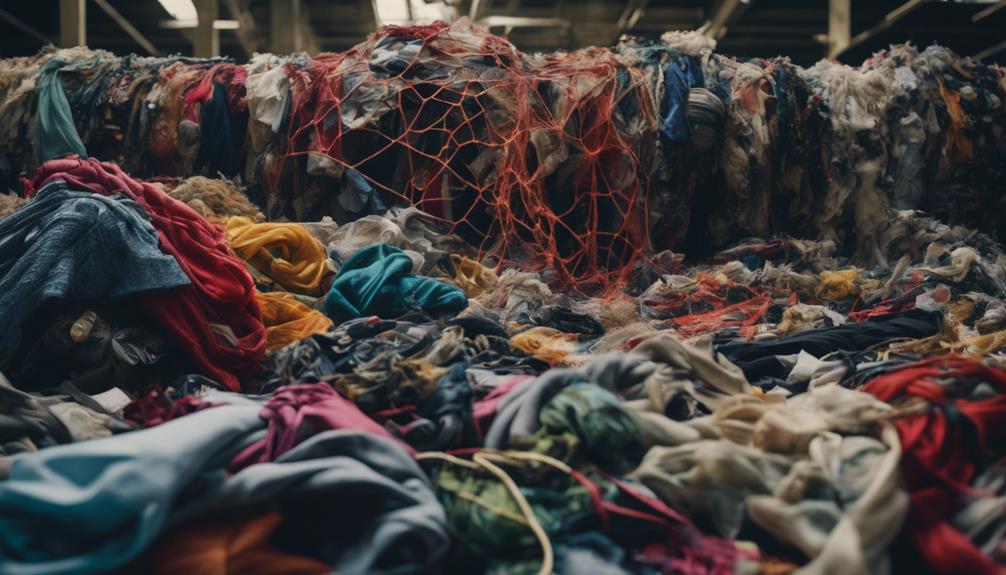
When you're exploring sustainable fashion, you'll quickly notice the hurdles of supply chain transparency and ethical production practices.
Many brands struggle to guarantee that every step of their process aligns with sustainability goals while maintaining affordability.
To tackle these challenges, you'll need to focus on building trust and fostering strong relationships with stakeholders.
Supply Chain Transparency
Steering through the complexities of global supply chains makes it tough for brands to uphold sustainable practices and communicate them clearly to consumers. You might find it frustrating when brands tout sustainability, yet their transparency leaves much to be desired. While some established brands create sustainable sections, these can easily become greenwashing tactics, misleading you about their true commitment to ethical practices.
Consider the following challenges in supply chain transparency:
- Hidden sourcing practices that obscure the origins of materials
- Inadequate information about production methods affecting textile waste
- Skepticism surrounding emerging brands lacking sales history
You deserve to understand where your clothing comes from and how it impacts the environment. Unfortunately, the fashion industry often falls short in disclosing essential information, making it hard for you to make informed choices.
With nearly 95% of textiles in landfills being recyclable, it's vital for brands to prioritize transparency and demonstrate genuine responsibility in their supply chains. Only then can you trust their sustainability claims and make better decisions for the planet.
Ethical Production Practices
While understanding supply chain transparency is important, the real challenge lies in ensuring ethical production practices throughout the fashion industry. Fast fashion brands often prioritize low costs over sustainable methods, making it tough for emerging labels to source ethical materials and guarantee fair labor. This systemic exploitation creates dire conditions, with many workers receiving wages far below what's necessary to live.
To better illustrate these challenges, consider the following table:
| Challenge | Impact |
|---|---|
| Low Production Costs | Compromises ethical practices |
| Complexity in Sourcing | Hinders sustainable supply chains |
| Worker Exploitation | Low wages and poor working conditions |
| Greenwashing by Established Brands | Misleads consumers about sustainability |
Brands must adapt and commit to continuous improvement to tackle these challenges. You play a vital role as a consumer; by demanding transparency and ethical production practices, you can help shift the industry away from fast fashion's damaging cycle. Your choices can pave the way for a more sustainable future in fashion.
Community Engagement and Awareness
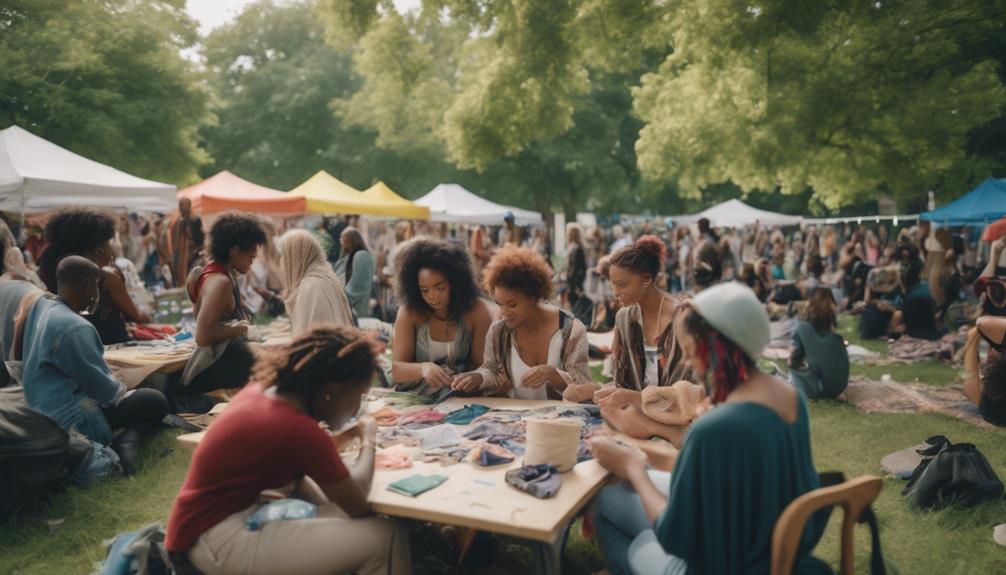
Community engagement drives awareness and fosters a collective responsibility to support sustainable fashion initiatives among consumers. When you actively participate in your community, you help create a ripple effect that encourages others to join the movement toward eco-friendly practices.
Imagine local workshops teaching how to upcycle clothing.
Consider community events like Second Hand September, where you explore thrift shops together.
Envision discussions about ethical production, highlighting brands that prioritize sustainability.
Think about sharing metrics like carbon footprints to enhance transparency among peers.
By engaging in these activities, you not only gain knowledge but also inspire others to rethink their purchasing habits. In India, for instance, 92% of adults are willing to pay more for sustainable products, showcasing the power of awareness.
When communities unite and share their experiences, they can overcome the challenges brands face and promote ethical practices more effectively.
Your involvement creates a culture of accountability and transparency, ensuring that sustainability becomes a priority in the fashion industry.
Future of Sustainable Fashion

The future of sustainable fashion hinges on a collective commitment to innovation and responsible practices, as the industry faces unprecedented challenges in consumption and waste.
With global apparel consumption projected to rise by 63% by 2030, reaching 102 million tons, the urgency for sustainable practices is undeniable. Currently, only 1% of textiles are reused, despite 95% being recyclable. This significant gap highlights the need for a robust approach to circular fashion initiatives.
Consumer awareness plays an essential role in driving this shift. By educating yourself and others on the environmental and social impacts of fast fashion, you can help create demand for sustainable options.
Effective sustainable fashion requires collaboration across the industry; recycling and rental models alone won't suffice. Systemic change is vital for genuine progress, which means rethinking current practices and policies.
As you engage with brands and advocate for sustainable choices, remember that every action counts. Together, we can challenge the status quo, pushing for innovative solutions that prioritize the planet and its people.
The responsibility lies with all of us to shape a sustainable future in fashion.
Frequently Asked Questions
Who Is Responsible for Sustainable Fashion?
You're responsible for sustainable fashion when you make conscious choices. By opting for eco-friendly brands, recycling clothes, and supporting secondhand markets, you can considerably reduce environmental impact and promote ethical practices in the fashion industry. Additionally, choosing timeless and high-quality pieces over fast fashion trends can also contribute to sustainable fashion design. By investing in garments that are made to last and using natural and biodegradable materials, you can further support the movement towards a more environmentally-friendly and socially responsible fashion industry. Ultimately, the power lies in the hands of consumers to drive the demand for sustainable fashion design and advocate for change within the industry.
Who Is Responsible for Being Sustainable?
You're responsible for being sustainable by making conscious choices in your consumption. Opt for eco-friendly products, support transparent brands, and advocate for accountability in the industry. Your choices can drive significant change in sustainability practices.
Who Is the Head of Sustainability Fashion?
You'll typically find the head of sustainability in a fashion company holding titles like Chief Sustainability Officer. This leader integrates eco-friendly practices, engages stakeholders, and collaborates across departments to align sustainability with overall business objectives.
What Is the Problem With Sustainable Fashion?
The problem with sustainable fashion is that despite claims, many brands still rely on harmful materials and practices. You'll find that recycling efforts and innovations often fall short, leaving the environmental impact largely unchanged.
Conclusion
In the end, the responsibility for sustainable fashion lies with all of us.
Think of it as a tapestry woven from the choices we make—each thread representing our actions.
By holding brands accountable, demanding transparency, and supporting ethical practices, you can help create a future where fashion doesn't cost the earth.
So, let's step up, be mindful consumers, and turn the tide against fast fashion.
Together, we can stitch a brighter tomorrow!
